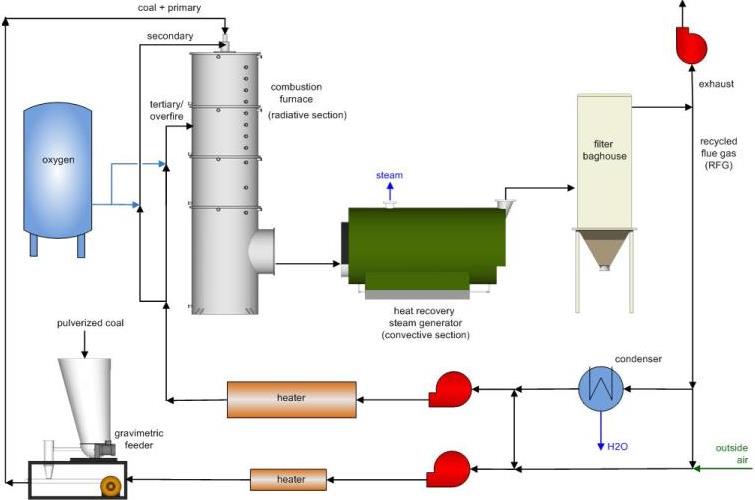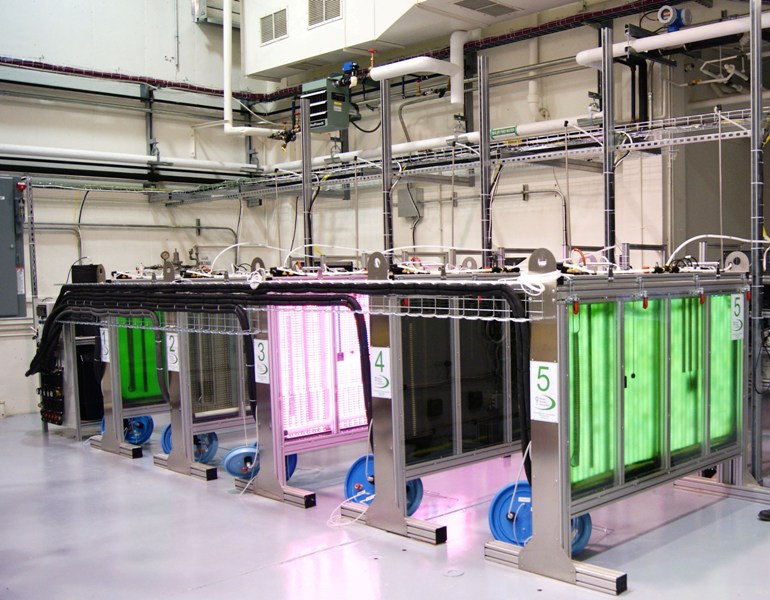In 2009 a bold plan was put into place to develop a modern, pilot-scale combustion test facility on the campus of Washington University in St. Louis. This facility would support the development and scale-up of new clean technologies to capture carbon dioxide from power plants and address the grand challenge facing the utilization of fossil fuels. Within a year, construction of the Advanced Coal & Energy Research Facility (ACERF) was completed, and coal research was put into the limelight.
The ACERF is in Urbauer Hall, centrally located within the School of Engineering & Applied Science among laboratories and classrooms and adjacent to a popular student dining/study center. From a large panel of windows, visitors and students can observe the operations in the two-story, 3,600-square-foot research space.
We wanted to be able to easily engage and interact with the students and community and to provide a visible demonstration of what advanced coal technologies look like, says Richard Axelbaum, PhD, director of ACERF. This facility attracts our most talented students and motivates them to pursue research that is both necessary and exciting.

Since its inception, ACERF has proven to be an invaluable educational resource, providing a unique hands-on experience for graduate and undergraduate engineering students who conduct research there. Students experience challenges with taking measurements and collecting data in a larger industrial-type setting outside of the laboratory. The top students are even trained to operate the system.
ACERF also is a destination for local primary education students and teachers. Visitors can learn about the various methods used to harvest the energy from coal, while preventing the emissions of carbon dioxide and other pollutants and compare these against other low-carbon energy sources. Using an interactive kiosk outside the ACERF control room, visitors can take an interactive tour of the facility and learn about the equipment, observe the real-time system data (temperature, pressure, flow, etc.), and access information on carbon dioxide capture and general energy data.
While the ACERF is a general purpose combustion test facility and well-suited for a variety of fuels and applications, it was appropriately developed with an emphasis on carbon capture. The system is designed to operate in both the oxy-combustion mode and the standard air-fired mode. In the oxy-combustion mode, the coal is burned in a mixture of oxygen and recycled flue gas instead of air. This eliminates up front the major component of combustion flue gas nitrogen and results in a stream of carbon dioxide that is ready for underground storage or utilization for oil or gas recovery. This is in contrast to post-combustion capture techniques, which aim to efficiently separate carbon dioxide from nitrogen and other traditional flue gas constituents, through the use of advanced sorbents or biological approaches.
Construction of the facility was supported by the Consortium for Clean Coal Utilization (CCCU), with donations from sponsors Arch Coal, Peabody Energy and Ameren Corp. The CCCU also supports activities within ACERF to develop and test advanced oxy-combustion methods aimed at lowering further the cost of carbon dioxide capture.
The main components are shown in the schematic diagram below. The facility features a cylindrical down-fired furnace that is capable of firing at a rate of 1 MWth. The burner was designed, constructed and tested by a team of students, faculty and tech support staff, and can use multiple fuels under air-fired and oxy-combustion conditions. The furnace is lined with a higher-temperature refractory material to accommodate potentially higher gas temperatures associated with oxy-combustion. There are numerous access ports along the furnace wall for temperature probe insertion, gas sample collection and particle analysis. The hot combustion products are cooled using a heat recovery steam generator. The low pressure steam that is produced is fed into a small steam distribution network and is utilized for building heat and water chilling thus the energy released during testing is recovered and not wasted. Particulates are removed in a high-efficiency fabric filter baghouse. The combustion furnace and the steam generator mimic the radiative and convective sections, respectively, of a larger-scale boiler.

A slipstream of flue gas may be pulled from various access points to investigate carbon capture and other pollutant control technologies. ACERF is also home to a series of large (100L each) photobioreactors for the production of biomass, such as cyanobacteria,or algae. Algae, through natural photosynthesis, may be used to capture and consume the carbon dioxide contained in the exhaust gas. These may operate either separately from the combustion facility, using stored or synthetic flue gas, or may be directly coupled in order to study and optimize the integration of these systems.

The ACERF is accessible to industry, faculty and students located within the U.S. and abroad. Services offered include burner testing, fuel testing (coal and alternative fuels), flue gas slipstream production and bioreactor rental. ACERF faculty and staff recently collaborated with two St. Louis-based companies: Akermin Inc., which conducted tests on its enzyme-based post-combustion capture technology; and Terra Biologics, LLC, which is developing technology for the production and application of biological soil crusts as a soil amendment.
